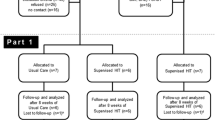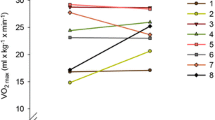Abstract
Objective
Long duration, moderate-intensity exercise is not well tolerated in patients with spinal and bulbar muscular atrophy (SBMA). This study investigated whether patients with SBMA can benefit from high-intensity training (HIT).
Methods
Ten patients with SBMA were randomized to 8 weeks of supervised HIT [n = 5; age = 50 (25–63) years] followed by 8 weeks of self-training or 8 weeks of no training followed by 8 weeks of non-supervised HIT [n = 5; age = 50 (26–54) years]. Training consisted of 2 × 5-min exercise periods with 1-min cyclic blocks of intermittent maximal intensity exercise on an ergometer bike. Maximal oxygen capacity (VO2max) and workload (Wmax) were measured before and after training by incremental exercise tests. Plasma creatine kinase levels, self-rated muscle pain, muscle fatigue, and activity level were monitored throughout the training period.
Results
Eight patients completed training. One patient dropped out after 5 weeks of training for private reasons. Another patient was excluded after 4 weeks due to lack of compliance. Eight weeks of training increased both VO2max (1.9 ± 2.3 ml min−1 kg−1; p = 0.04) and Wmax (15.6 ± 17.9 W; p = 0.03) in the 8 patients who completed training. There were no changes in plasma creatine kinase levels, self-reported muscle pain or muscle fatigue activity level after training.
Conclusion
This pilot study suggests that high-intensity training is safe and improves fitness in patients with SBMA. Unlike low- and moderate-intensity training, HIT is efficacious and favored over other training forms by the patients.


Similar content being viewed by others
References
Preisler N, Andersen G, Thogersen F, Crone C, Jeppesen TD, Wibrand F et al (2009) Effect of aerobic training in patients with spinal and bulbar muscular atrophy (Kennedy disease). Neurology 72(4):317–323
Shrader JA, Kats I, Kokkinis A, Zampieri C, Levy E, Joe GO et al (2015) A randomized controlled trial of exercise in spinal and bulbar muscular atrophy. Ann Clin Transl Neurol 2(7):739–747
Madsen KL, Hansen RS, Preisler N, Thøgersen F, Berthelsen MP, Vissing J (2015) Training improves oxidative capacity, but not function, in spinal muscular atrophy type III. Muscle Nerve 52(2):240–244
Dahlqvist JR, Vissing J (2015) Exercise therapy in spinobulbar muscular atrophy and other neuromuscular disorders. J Mol Neurosci 58:388–393
Helgerud J, HøYdal K, Wang E, Karlsen T, Berg P, Bjerkaas M et al (2007) Aerobic high-intensity intervals improve VO2max more than moderate training. Med Sci Sports Exerc 39(4):665–671
Iaia FM, Thomassen M, Kolding H, Gunnarsson T, Wendell J, Rostgaard T et al (2008) Reduced volume but increased training intensity elevates muscle Na + –K + pump α1-subunit and NHE1 expression as well as short-term work capacity in humans. Am J Physiol Regul Integr Comp Physiol 294(3):R966–R974
Tabata I, Nishimura K, Kouzaki M, Hirai Y, Ogita F, Miyachi M et al (1996) Effects of moderate-intensity endurance and high-intensity intermittent training on anaerobic capacity and [spacing dot above]VO2max. [Miscellaneous Article]. Med Sci Sports Exerc 28(10):1327–1330
Gunnarsson TP, Bangsbo J (2012) The 10-20-30 training concept improves performance and health profile in moderately trained runners. J Appl Physiol 113(1):16–24
Statement ATS (2002) Am J Respir Crit Care Med 166(1):111–117
Montes J, Garber CE, Kramer SS, Montgomery MJ, Dunaway S, Kamil-Rosenberg S et al (2015) Single-blind, randomized, controlled clinical trial of exercise in ambulatory spinal muscular atrophy: why are the results negative? J Neuromuscular Dis 2(4):463–470
Author information
Authors and Affiliations
Contributions
KH: design of study, analysis, acquisition, and interpretation of data and drafting the manuscript. GA: design of study, analysis, acquisition, and interpretation of data and critical revision of manuscript. AB: analysis, acquisition of data, and critical revision of manuscript. HA: acquisition of data and critical revision of manuscript. JV: design of study, interpretation of data, and critical revision of the manuscript.
Corresponding author
Ethics declarations
Conflicts of interest
Dr. Andersen, Dr. Heje, and Dr. Buch reports no disclosure. Dr. Vissing reports having received research and travel support, and/or speaker honoraria from Sanofi/Genzyme, Ultragenyx Pharmaceuticals, Santhera Pharmaceuticals and aTyr Pharma, and served as consultant on advisory boards for Sanofi/Genzyme, aTyr pharma, Ultragenyx Pharmaceuticals, Santhera Pharmaceuticals, Sarepta Therapeutics, NOVO Nordisk, Alexion Pharmaceuticals and Stealth Biotherapeutics within the last 3 years.
Rights and permissions
About this article
Cite this article
Heje, K., Andersen, G., Buch, A. et al. High-intensity training in patients with spinal and bulbar muscular atrophy. J Neurol 266, 1693–1697 (2019). https://doi.org/10.1007/s00415-019-09316-x
Received:
Revised:
Accepted:
Published:
Issue Date:
DOI: https://doi.org/10.1007/s00415-019-09316-x




